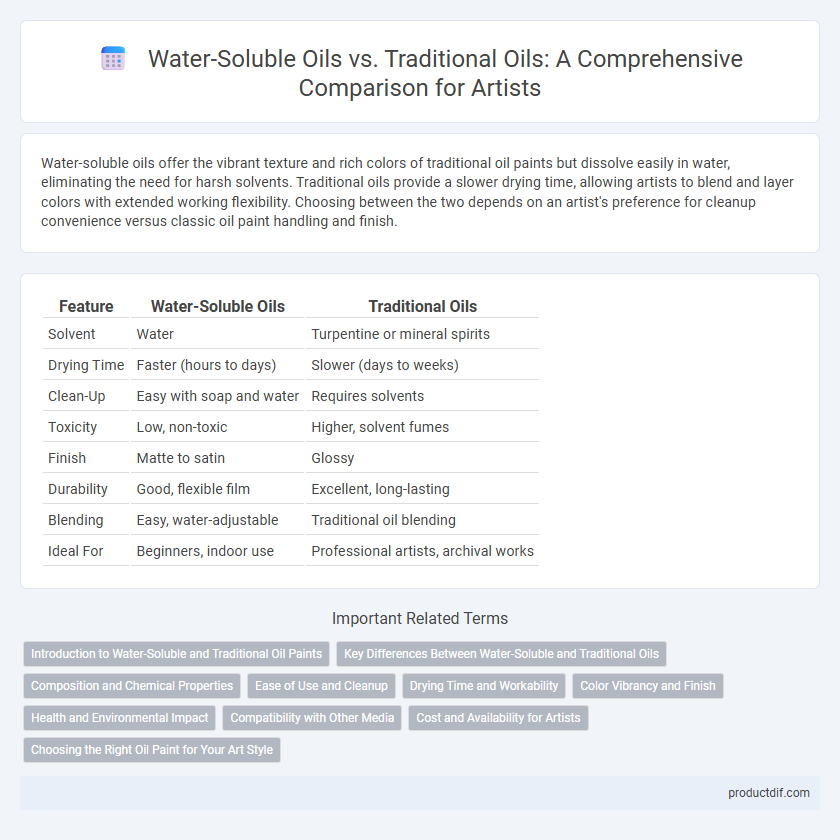Water-soluble oils offer the vibrant texture and rich colors of traditional oil paints but dissolve easily in water, eliminating the need for harsh solvents. Traditional oils provide a slower drying time, allowing artists to blend and layer colors with extended working flexibility. Choosing between the two depends on an artist's preference for cleanup convenience versus classic oil paint handling and finish.
Table of Comparison
| Feature | Water-Soluble Oils | Traditional Oils |
|---|---|---|
| Solvent | Water | Turpentine or mineral spirits |
| Drying Time | Faster (hours to days) | Slower (days to weeks) |
| Clean-Up | Easy with soap and water | Requires solvents |
| Toxicity | Low, non-toxic | Higher, solvent fumes |
| Finish | Matte to satin | Glossy |
| Durability | Good, flexible film | Excellent, long-lasting |
| Blending | Easy, water-adjustable | Traditional oil blending |
| Ideal For | Beginners, indoor use | Professional artists, archival works |
Introduction to Water-Soluble and Traditional Oil Paints
Water-soluble oil paints combine the rich texture and slow drying time of traditional oil paints with the convenience of cleanup using only water, eliminating the need for solvents like turpentine. Traditional oil paints utilize linseed or walnut oil as binders, providing vibrant colors and excellent blending abilities but require mineral spirits or other solvents for thinning and cleaning. Artists often choose water-soluble oils for a safer, more eco-friendly studio environment without sacrificing the durability and depth that characterize classic oil painting.
Key Differences Between Water-Soluble and Traditional Oils
Water-soluble oils blend the rich texture of traditional oils with the ease of water cleanup, eliminating the need for harsh solvents like turpentine. Traditional oils offer longer drying times that allow for detailed blending and layering, while water-soluble oils dry faster, catering to artists seeking quicker results. The chemical composition of water-soluble oils includes emulsifiers that enable water dilution, contrasting with traditional oils' reliance on oil-based solvents for thinning and cleaning.
Composition and Chemical Properties
Water-soluble oils feature an alkyd resin base modified with water-dispersible agents, allowing easy dilution and cleanup with water, while traditional oils utilize natural or synthetic oils like linseed or safflower that require solvents such as turpentine for thinning and cleaning. The chemical composition of water-soluble oils includes emulsifiers that enable water integration without affecting the oil's drying through oxidation, whereas traditional oils rely solely on oxidative polymerization for drying and durability. These differences in chemical properties influence drying time, finish flexibility, and environmental impact, making water-soluble oils a preferred choice for artists seeking less toxic alternatives without sacrificing the texture and richness of traditional oil paints.
Ease of Use and Cleanup
Water-soluble oils offer superior ease of use compared to traditional oils due to their ability to dilute with water, eliminating the need for harsh solvents like turpentine or mineral spirits. Cleanup is significantly simpler with water-soluble oils, requiring only soap and water, making them more convenient for artists working in shared or small spaces. Traditional oils, while rich in texture and drying durability, demand solvent-based cleanup, increasing preparation time and exposure to strong chemical odors.
Drying Time and Workability
Water-soluble oils offer faster drying times, typically within 24 to 48 hours, compared to traditional oils that can take several days to weeks to dry completely. Their increased workability allows artists to blend and modify paint with water, providing more immediate control and flexibility during the painting process. Traditional oils maintain extended open times, ideal for techniques requiring prolonged manipulation and smoother gradations.
Color Vibrancy and Finish
Water-soluble oils offer enhanced color vibrancy due to their ability to blend seamlessly with water, creating luminous and bright finishes that rival traditional oils. Traditional oils provide a rich, glossy finish with deeper saturation, but require solvents that can dull colors over time. Artists seeking quick-drying, vibrant hues often prefer water-soluble oils for their versatility and cleaner finish.
Health and Environmental Impact
Water-soluble oils contain fewer toxic solvents compared to traditional oils, reducing harmful fumes and minimizing health risks for artists. These oils are biodegradable and easier to clean with water, leading to a lower environmental footprint than conventional oil paints that require harsh chemical solvents for cleaning. Choosing water-soluble oils promotes safer studio air quality and less hazardous waste disposal, aligning with eco-friendly art practices.
Compatibility with Other Media
Water-soluble oils offer enhanced compatibility with various media, allowing seamless blending with watercolors and acrylics without compromising texture or drying time. Traditional oils require solvents for thinning and cleanup, which limits their mixing potential with water-based paints and often demands separate techniques. Artists benefit from water-soluble oils when seeking versatile layering and mixed media effects in their artwork.
Cost and Availability for Artists
Water-soluble oil paints generally cost more upfront than traditional oils but eliminate the need for expensive solvents, potentially reducing overall expenses for artists. Traditional oil paints are widely available in numerous brands and art stores, offering a broader range of price points and pigment options. Water-soluble oils provide increased accessibility for beginners seeking non-toxic alternatives, whereas traditional oils remain preferred by professionals for their rich texture and longevity despite higher maintenance costs.
Choosing the Right Oil Paint for Your Art Style
Water-soluble oils combine the rich texture and slow drying time of traditional oil paints with the convenience of water cleanup, making them ideal for artists seeking versatility and less toxic handling. Traditional oils offer unparalleled depth of color and blending capabilities, preferred by artists who prioritize long-lasting, archival quality and classic painting techniques. Selecting between water-soluble and traditional oils depends on your art style, studio environment, and preference for ease of use versus traditional oil characteristics.
Water-Soluble Oils vs Traditional Oils Infographic

 productdif.com
productdif.com